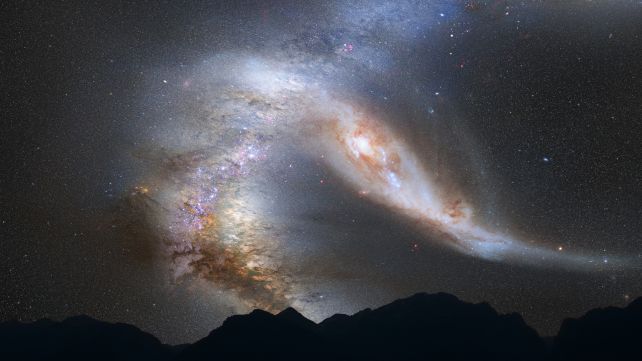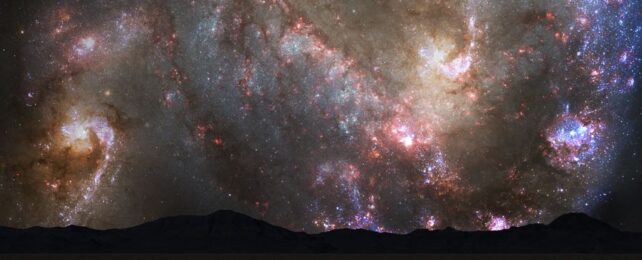"As it stands, proclamations of the impending demise of our Galaxy seem greatly exaggerated."
That's the conclusion scientists have reached after revisiting the possibility of what we thought was a foregone conclusion: the eventual clash of giants, a collision between the Milky Way and the Andromeda galaxies.
Led by astrophysicist Till Sawala of the University of Helsinki, a team of scientists has calculated that, in the next 10 billion years, the chance of a collision between the two galaxies is very close to 50 percent.
In other words, there is just as much of a chance of collision as there is of the galaxies sailing right past each other, like ships in the eternal cosmic night.
"We don't find that previous calculations were wrong – quite the contrary, when we start from the same assumptions, we reproduce the earlier results," Sawala told ScienceAlert.
"However, we now find that the earlier prediction of a Milky Way-Andromeda collision is only one of several possibilities. Of course, the fate of the Local Group is not chaotic – with even better data, there will be a definite answer to the question of whether the Milky Way and Andromeda will merge or not, so our study certainly won't be the final word on this issue."

The Milky Way-Andromeda collision has been predicted by scientists for years, occurring in an estimated timeframe of about 4.5 billion years. The predicted fusion of the two galaxies has been dubbed "Milkomeda", and has been considered to be all-but-inevitable.
The Milky Way and Andromeda are not, however, alone in this little corner of the cosmos. They belong to a small group of galaxies within a radius of about 5 million light-years from the Milky Way known as the Local Group. The Milky Way and Andromeda are the largest members, but there are quite a few other objects hanging out that need to be taken into consideration when modeling the future.
Sawala and his colleagues took the latest data from the Hubble and Gaia space telescopes, and the most recent mass estimates for the four most massive objects in the Local Group – the Milky Way, Andromeda, the Triangulum galaxy (M33), and the Large Magellanic Cloud (LMC).
Then, they set about running simulations of the next 10 billion years, adding and removing galaxies to see how that changed the results.

"Almost all of astrophysics, and actually all of my own previous work, is focused on trying to understand the past – how we got here, and why. There are good reasons for that, but I think it's also fascinating to think about the future," Sawala explained.
"Initially, I was motivated to understand the potential impact of the wider cosmic environment on the Milky Way-Andromeda encounter, but as we show, there is actually a lot of complexity and uncertainty even in the relatively simple three- or four-body systems."
Their results showed that the presence of M33 and LMC dramatically altered the probability of a collision between the Milky Way and Andromeda. When it is just the two large spiral galaxies, the merger occurred in slightly less than half the simulation runs.
The addition of M33 increased the merger probability to two in three. Taking M33 back out and adding LMC had the opposite effect, decreasing the probability to one in three.
When all four galaxies were present, the probability of a merger between the Milky Way and Andromeda within 10 billion years is slightly more than 50 percent.

"We find that there are basically two types of outcomes," Sawala said.
"The Milky Way and Andromeda will either come close enough on their first encounter (first 'pericenter') that dynamical friction between the two dark matter haloes will drag the orbit to an eventual merger, which very likely happens before 10 billion years, or they do not come close enough, in which case dynamical friction is not effective, and they can still orbit for a very long time thereafter."
That 10 billion-year timeframe was chosen because it was well beyond the timeframe in which the merger was predicted to occur, but the further you try to peer into the future, the more difficult it becomes to predict. That's because other factors that can't be predicted may come into play; the further forward you go, the more likely those factors are to appear.
This is far from the final word on the matter, however. Although we have access to some pretty great data now, ongoing observations and future instruments will be able to refine the measurements of motions and masses of objects in the Local Group to inform more detailed simulations in the future.
"The main result of our work is that there is still significant uncertainty about the future evolution – and eventual fate – of our galaxy," Sawala said.
"Of course, as a working astrophysicist, the best results are those that motivate future studies, and I think our paper provides motivation both for more comprehensive models and for more precise observations."
The research has been published in Nature Astronomy.
